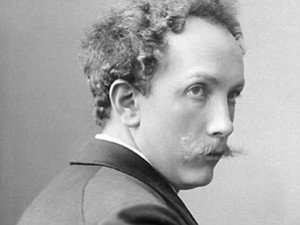 Facebook
Facebook
 X
X
 Instagram
Instagram
 TikTok
TikTok
 Youtube
Youtube

What is an intermezzo? There are several famous musical intermezzi such as those found in Cavalleria Rusticana and Pagliacci but there is also an entire opera entitled Intermezzo by Richard Strauss. What gives?
In the 18th Century an intermezzo was a comedic episode which took place between the acts of a serious opera. They often contained stock characters such as those found in commedia dell’arte. The subject was separate from the serious opera. In modern terms an intermezzo was the comic relief. Sometimes the comedy was based on married life and mistaken identity which is where Strauss’ opera comes in.
Strauss used the title Intermezzo as something of a wink at the tradition, but in this case he didn’t use stock characters. The characters he used were based upon himself and his wife Pauline.
However, Strauss did not inform his wife that this was the case. She attended the premiere oblivious of what was to be presented. Intermezzo is a mistaken identity comedy but one can only imagine how Pauline felt when she saw herself onstage in the form of the lead soprano “Christine”.
We do get something of a clue as to how Pauline felt when, after the show, the lead soprano congratulated her on receiving such a wonderful gift from her husband. “I don’t give a damn,” was Pauline’s response.
The Pauline character has been described as self-dramatizing and temperamental — all in good fun my dear. The habit of belittling one’s spouse with humor was raised to the level of art by Strauss.
Did Strauss put an intermezzo in his Intermezzo? No. He put in four “symphonic interludes” which are often performed under their own merit. The most famous of the four is probably Träumerei am Kamin — Dreaming by the Fireside.
I think Träumerei is a perfect representation of Strauss’ abilities as a composer. It is concise and yet Träumerei feels as profound as any of the official tone poems such as Also Sprach Zarathustra which is close to an hour long.
Intermezzo is a mature work which was written when Strauss was 58 years of age. Chauvinism aside, the score is regarded as one of Strauss’ finest, but the tasteless subject matter has kept it from being performed very often. The U.S. premiere wasn’t until 1984, 60 years after the premiere.
I can only imagine how the “I’m with her” crowd would respond to a production of Intermezzo.


What is an intermezzo? There are several famous musical intermezzi such as those found in Cavalleria Rusticana and Pagliacci but there is also an entire opera entitled Intermezzo by Richard Strauss. What gives?
In the 18th Century an intermezzo was a comedic episode which took place between the acts of a serious opera. They often contained stock characters such as those found in commedia dell’arte. The subject was separate from the serious opera. In modern terms an intermezzo was the comic relief. Sometimes the comedy was based on married life and mistaken identity which is where Strauss’ opera comes in.
Strauss used the title Intermezzo as something of a wink at the tradition, but in this case he didn’t use stock characters. The characters he used were based upon himself and his wife Pauline.
However, Strauss did not inform his wife that this was the case. She attended the premiere oblivious of what was to be presented. Intermezzo is a mistaken identity comedy but one can only imagine how Pauline felt when she saw herself onstage in the form of the lead soprano “Christine”.
We do get something of a clue as to how Pauline felt when, after the show, the lead soprano congratulated her on receiving such a wonderful gift from her husband. “I don’t give a damn,” was Pauline’s response.
The Pauline character has been described as self-dramatizing and temperamental — all in good fun my dear. The habit of belittling one’s spouse with humor was raised to the level of art by Strauss.
Did Strauss put an intermezzo in his Intermezzo? No. He put in four “symphonic interludes” which are often performed under their own merit. The most famous of the four is probably Träumerei am Kamin — Dreaming by the Fireside.
I think Träumerei is a perfect representation of Strauss’ abilities as a composer. It is concise and yet Träumerei feels as profound as any of the official tone poems such as Also Sprach Zarathustra which is close to an hour long.
Intermezzo is a mature work which was written when Strauss was 58 years of age. Chauvinism aside, the score is regarded as one of Strauss’ finest, but the tasteless subject matter has kept it from being performed very often. The U.S. premiere wasn’t until 1984, 60 years after the premiere.
I can only imagine how the “I’m with her” crowd would respond to a production of Intermezzo.
Comments